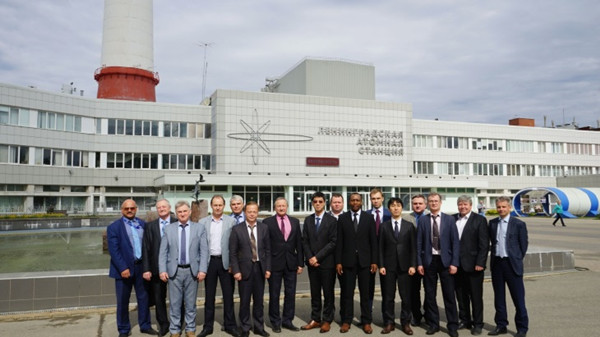Rosenergoatom, the operator of Russia's Leningrad nuclear power plant, has strengthened operational safety in response to the findings of an International Atomic Energy Agency (IAEA) review in 2017, a follow-up mission has concluded. The team encouraged the operator to pursue continuous improvement.

Representatives of the IAEA mission team and Russian counterparts during a meeting on the OSART follow-up mission to Leningrad plant (Photo: Leningrad NPP)
OSART missions aim to improve operational safety by objectively assessing safety performance using the IAEA's Safety Standards and proposing recommendations for improvement where appropriate. The follow-up missions are standard components of the OSART programme.
In November 2017, the IAEA completed a 17-day mission to Leningrad unit 4, which was connected to the grid in 1981 and is one of four light water-cooled graphite-moderated reactors (RBMK-1000) located at the site in Sosnovy Bor, 70 km west of St Petersburg. Plant operator Rosenergoatom is a subsidiary of Russian state nuclear corporation Rosatom.
That mission made suggestions for improving operational safety at the plant, including: the use of leading indicators to further improve its performance; strengthening the radiation protection programme; and regular reviews of chemistry surveillance and control programme to ensure its continuous improvement.
A three-member OSART team - comprising one expert from South Africa and two officials from the IAEA - concluded a five-day follow-up mission to Leningrad 4 on 24 May.
"Notable efforts and actions were taken to address the findings of the 2017 mission, indicating a strong commitment to continuously improving safety by the plant management," said team leader Fuming Jiang, a senior nuclear safety officer at the IAEA. "We encourage the plant management to continue this momentum to take the performance to the next level."
The follow-up mission found improvements to control of movable items in some sensitive areas in the plant; the use of human performance tools; and the plant chemistry surveillance and control programme.
However, the team noted that more time is required to demonstrate that improvements are fully effective and sustained in the use of forward-looking and proactive performance indicators at the plant, and in the radiation contamination control programme.
The OSART team provided a draft of its report to the plant's management and will submit the final report to the Russian government within three months.
Vladimir Pereguda, Leningrad NPP station director, said: "We have systematically applied the OSART methodology since 2014 and, together with the insights and advice provided by the 2017 mission, it has proven to be very beneficial to our efforts to continuously strengthen operational safety performance. The OSART mission has helped us to move our operational safety performance to a new level, and we will continue our effort in this journey to nuclear excellence."
Located on the coast of the Gulf of Finland, Leningrad NPP is Russia's biggest nuclear power plant in terms of its installed capacity, which is 4200 MWe. It is also the only plant in the country comprising two types of reactor: Phase I of the plant comprises four RBMK-1000 units, while Phase II will have four VVER-1200 units. Leningrad unit 1 was shut down for decommissioning on 21 December last year.